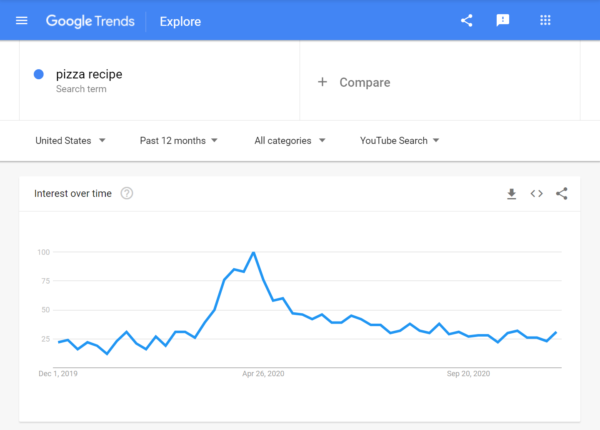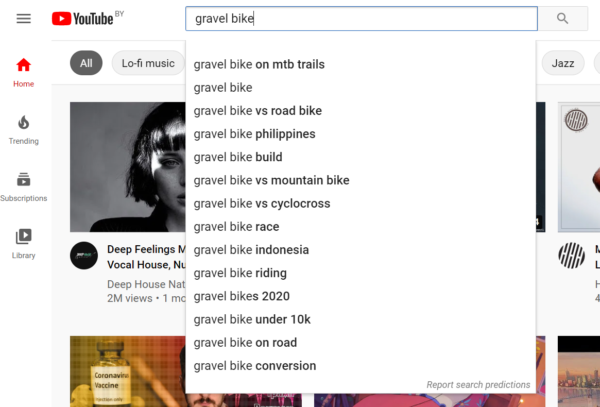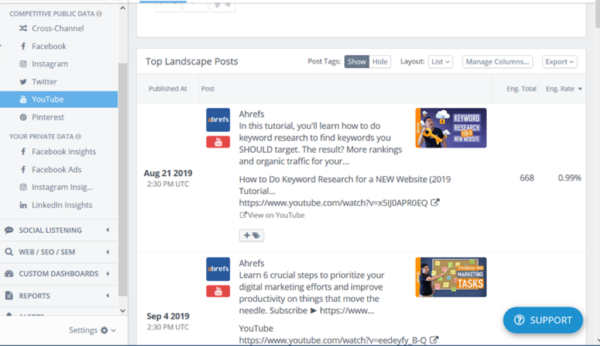 Updated Jan. 14, 2021
Updated Jan. 14, 2021
When you think of search engines, it’s usually Google, Microsoft Bing, and Yahoo. And yet, as one of the largest search engines in the world, with more than 2 billion monthly active users, is YouTube.
Most people consider YouTube as a social media platform, which it is, but it also behaves a lot like a traditional search engine. Visitors enter their query and get a list of videos ranked by relevance.
That’s why optimizing video content is critical to ranking and accessing the audience on YouTube. Fortunately, a lot of the traditional SEO rules apply here as well. Find the right keywords to communicate relevance, design a good user experience to drive engagement, and use analytics to find and fix whatever is not working.
Optimizing #video content is critical to rank well on one of the world’s largest search engines, @YouTube, says @ab80 via @CMIContent. Click To Tweet
With that said, here’s a rundown of tools to help you manage your YouTube SEO. Some are your general, run-of-the-mill SEO tools. Others are designed specifically for YouTube. But every single one is useful for growing your YouTube presence.
Look up topics in Google Trends
Turn to Google Trends to see whether interest in your chosen topic is up or down. While you may be familiar with the overall Google Trends feature, click on “YouTube Search” to explore the video-related opportunities. Given that the data is coming from Google (which owns YouTube), it’s as trustworthy as it gets:

Identify the best keywords
To get your video content found, use the right keywords in your title, description, and tags.
The first place to look for the right keywords is YouTube’s autocomplete feature – start typing your seed keyword into the search bar and see how YouTube interprets it by showing autocomplete suggestions:

Use @YouTube’s autocomplete feature to identify the best keywords, advises @ab80 via @CMIContent. #SEO Click To Tweet
If you have a bunch of keywords, you can automate the process with the help of a specialized keyword research tool. The free version of Rank Tracker (disclosure, I am the creator) allows you to use nine keyword research methods, which are likely to result in thousands of prospective keywords. Don’t worry; you can narrow the selection with the use of custom filters — aim for the highest search volume and the lowest competition.
For something lighter and more convenient, look into Keywords Everywhere. The browser extension allows research of keywords on the go. It greatly augments the autocomplete features of YouTube and Google with valuable metrics.
Another handy solution for keyword research is AnswerThePublic – a beautifully designed online tool that allows you to research the most common questions associated with your keywords.
Keywordtool.io and Kparser are paid solutions for keyword research that provide cost per click (CPC) and search volume. Keyword Keg is a similar tool. The free version is limited, but the paid version is suitable for marketers running larger volume campaigns.
Finally, you can turn to the Keyword Planner section of your Google Ads account and enter your seed keywords to get a bunch of closely related keywords. One downside with a free account is that you do not get the exact search volumes for your keywords, just approximations.
Research the most profitable tags
Tags are added to YouTube videos by creators, and they help YouTube place the videos into proper categories. The problem is tags are not displayed on tvideo’s page, so researching them is a hassle.
You can either open the source code of the page and look for tags there or install a browser extension that will do the job for you. Personally, I prefer vidIQ Vision for YouTube — it analyzes videos on the go and provides a summary on the page, complete with the tags and a bunch of other stuff:

.@vidIQ analyzes #videos and provides a summary on the page complete with tags, says @ab80 via @CMIContent. #tools Click To Tweet
Tags for YouTube is another browser extension that shows the tags for each opened YouTube video. It provides a nice overview of any video ranking for your topic.
RapidTags generate multiple tags related to your topic. Put in the URL or topic of your video and see what tags come up. One downside, though, its free version is limited.
Add #video’s URL or topic to @RapidTagsPromo to see multiple tags related to your topic & level of engagement to rank, says @AB80 via @CMIContent. #tools Click To Tweet
Manage and audit your channel
Always keeping an eye on your successes and failures is a natural necessity. Knowing which videos are working for your brand – and which ones aren’t – can help you understand the effect of your keywords and inform future opportunities.
YouTube Analytics (YouTube’s native tool) provides an overview of your channel. It’s accessible through your channel’s dashboard. It tells you who your audience is and what other stuff they enjoy watching. You can see the timeline of views/engagement with your audience as well. It’s made for people who already have a number of videos and want to survey their success.
Also worth a mention is TubeBuddy. It is one of the most feature-rich apps for running and optimizing your YouTube channel. You can use it to analyze your channel’s stats and perform competition research. You can also edit your video data: thumbnails, annotations, and descriptions.
.@TubeBuddy is the most feature-rich app for running & optimizing your @YouTube channel on the market, says @AB80 via @CMIContent. #tools Click To Tweet
Tubics is a similar tool. It provides you with the tools for keyword research, channel audit, and more. Though quintly is not specifically created for YouTube, it is easy to integrate. In addition to data on subscribers, engagement, watch time, and so on, it provides a convenient reporting feature.
Research your competitors
By using tools like Rival IQ you can get a full profile of your competitors’ YouTube presence. You can see a general outline of their growth, what works, what doesn’t, what tags they are using, etc. Use this information to create more effective videos and text-based content.

.@RivalIQ can give detailed profiles of your competitors’ @YouTube channels, says @ab80 via @CMIContent. #tools Click To Tweet
Alternatively, you can use NoxInfluencer. Not only does it help you evaluate your channel, but you can see the best-performing videos in a category or location. That makes it indispensable in SEO research.
YouTube Competitors Analysis Tool by Socialinsider provides an in-depth look at the history of ranking and performance of your and your competitors’ content.
Moderate your comment section
Though you may not think of the comments section as an SEO factor, it can have an indirect effect on your rankings. Comments can make or break your YouTube channel. Sometimes the comments under the most innocuous, helpful videos could be such a vile pit of rot that it’ll harm a brand in a very real way.
Comments can make or break your @YouTube channel, says @ab80 via @CMIContent. #SEO Click To Tweet
The YouTube comment moderation feature is probably the best tool for this task. You can add filters to automatically deal with inappropriate commenters and create a list of forbidden words to quarantine comments incorporating them.
Smart Moderation does the same thing across several platforms at once. The comments with the forbidden words aren’t just quarantined but deleted forever.
Watch your YouTube SEO
YouTube is the definitive content platform for millions of people around the world. To make the most of it, brand marketers need to think about SEO before the content is even created and follow through long after the videos are posted. Not doing so means you’re investing in videos never to realize their potential on YouTube.
All tools mentioned in the article are identified by the author. If you have a tool to suggest, please feel free to add it in the comments.
Cover image by Joseph Kalinowski/Content Marketing Institute
- Home page
- Content Marketing
- Digital Marketing Strategy
- Digital Marketing Strategy
- Digital Marketing Strategy
- PPC
- SEO
- Social maketing
- WordPress web development


